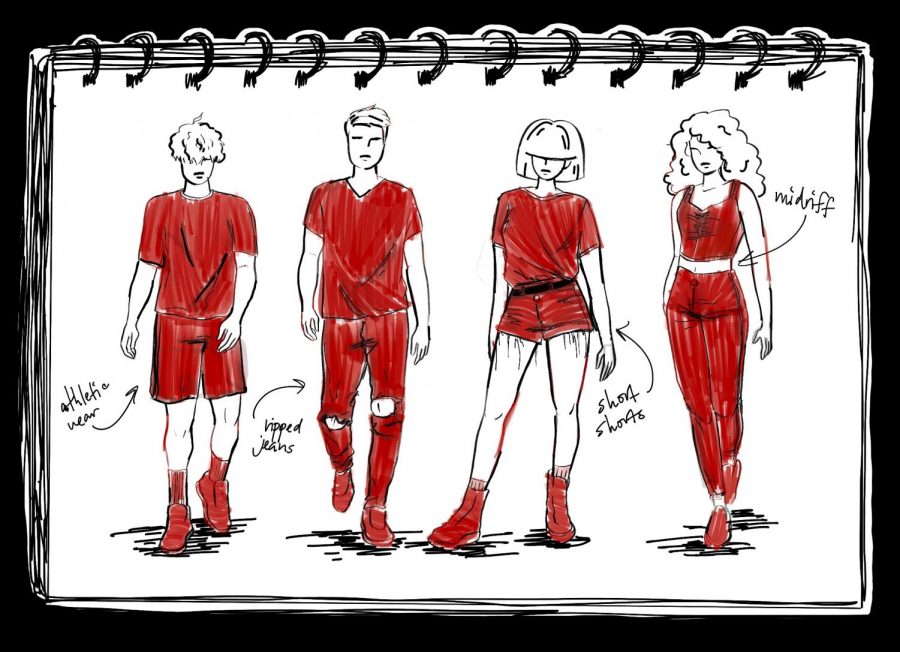Twill pants to tank tops: The decade-long evolution of the dress code
Understanding the roots of the dress code controversy
We have now been back on campus for almost a month, after a year and a half apart. As we have transitioned back into a fully in-person environment filled with interaction beyond faces on a laptop screen, we have also tackled the return to in-person attire.
We have now been back on campus for almost a month, after a year and a half apart. As we have transitioned back into a fully in-person environment filled with interaction beyond faces on a laptop screen, we have also tackled the return to in-person attire.
When we returned to hybrid learning last spring, our safe return was prioritized above adhering to a dress code. Half of our campus had never experienced an entire year abiding by the guidelines for dress. Still facing the aftermath of quarantine, we needed time to readjust to the rigors of a normal school year while maintaining our physical and mental health, before concerning ourselves with the issue of appropriate clothing.
Discourse about dress code at Harker is not new, and the current community guidelines are the latest in a long series of iterations that go back through the decades. The dress code from the 1999-2000 school year required collared shirts, banned blue jeans and limited logo sizes to pocket-sized. The guidelines became increasingly detailed, and the 2009-2010 code narrowed down clothing to categories such as “twill pants.” In 2012-2013, it spanned over four pages and “patterned shirts which fall at least two inches below the top of the pant.”
The most recent major revisions to the dress code occurred in 2016, when student advocacy resulted in a shift from a structured dress code to a 282-word list of community expectations that utilized broader terms to dictate that dress should be “clean” and not “too casual.”
It was the updated 2016 community expectations that we returned to after life in a pandemic setting.
But it was the vigorous and immediate enforcement of dress guidelines following the announcement of the school’s policy that generated controversy among students over the next three weeks. Students expressed viewpoints from the difficulty of shopping for girls’ clothing and gender bias to ire over Williamson’s statement in an email sent to all upper school families that dress defines “respect for the many ethnicities and religious backgrounds that are a part of our rich and culturally diverse community, our teachers in the classrooms, as well as the many visitors that we host on campus each day.”
Resolving this debate starts with communication. From a student’s perspective, in the rush to get to school, deliberating over the dress code adds unnecessary stress to time that should be utilized to prepare for a full day of learning.
If we stand straighter, then our shorts will be closer to fingertip length. But, what if we are off by half an inch?
If we pull the hems of our shirts down, they cover our midriffs. But, what if our shirts lift up slightly when raising our hands?
If we wear athletic shorts, we’ll definitely be dress coded. But, what if we wear athletic pants?
On Sept. 1, juniors met with Williamson to present a petition for proposed changes, including specifying current guidelines. Last Wednesday, ASB and the SDC organized a schoolwide town hall to offer the microphone for discourse regarding student dress.
Moving forward, members of ASB, Honor Council, SDC, Gender and Sexuality Alliance (GSA), and FEM club will represent student interests in an effort to continue conversations with the administration regarding dress code, with the group’s first meeting set for Monday during morning office hours.
These initiatives represent organized forms of advocacy that emphasize open communication between students and the administration. Committing to both sides of this conversation means advocacy through listening to each other and seeking out reason before jumping to conclusions. This is the path we must follow if we want to create meaningful and lasting change.
I suggest that students and administration coordinate to clear up the vagaries surrounding what exactly counts as casual, one of the main sentiments expressed at the town hall. Clarify what can or cannot be worn, and share the results of the dress code discussions among various student organizations with the entire student body. By establishing a uniform policy for faculty to enforce the dress code, we truly create an environment for respect.

Muthu Panchanatham (12) is the opinion editor of Harker Aquila and The Winged Post, and this is his fourth year on staff. This year, he is excited to cover...

Alysa Suleiman (12) is the co-editor-in-chief of Harker Aquila. This is her fourth year on staff, and she previously served as Aquila's first A&E editor,...

Emily Tan (12) is the co-editor-in-chief of The Winged Post. This is her fourth year on staff, previously serving as the Winged Post features editor, and...


















![“[Building nerf blasters] became this outlet of creativity for me that hasn't been matched by anything else. The process [of] making a build complete to your desire is such a painstakingly difficult process, but I've had to learn from [the skills needed from] soldering to proper painting. There's so many different options for everything, if you think about it, it exists. The best part is [that] if it doesn't exist, you can build it yourself," Ishaan Parate said.](https://harkeraquila.com/wp-content/uploads/2022/08/DSC_8149-900x604.jpg)




![“When I came into high school, I was ready to be a follower. But DECA was a game changer for me. It helped me overcome my fear of public speaking, and it's played such a major role in who I've become today. To be able to successfully lead a chapter of 150 students, an officer team and be one of the upperclassmen I once really admired is something I'm [really] proud of,” Anvitha Tummala ('21) said.](https://harkeraquila.com/wp-content/uploads/2021/07/Screen-Shot-2021-07-25-at-9.50.05-AM-900x594.png)







![“I think getting up in the morning and having a sense of purpose [is exciting]. I think without a certain amount of drive, life is kind of obsolete and mundane, and I think having that every single day is what makes each day unique and kind of makes life exciting,” Neymika Jain (12) said.](https://harkeraquila.com/wp-content/uploads/2017/06/Screen-Shot-2017-06-03-at-4.54.16-PM.png)








![“My slogan is ‘slow feet, don’t eat, and I’m hungry.’ You need to run fast to get where you are–you aren't going to get those championships if you aren't fast,” Angel Cervantes (12) said. “I want to do well in school on my tests and in track and win championships for my team. I live by that, [and] I can do that anywhere: in the classroom or on the field.”](https://harkeraquila.com/wp-content/uploads/2018/06/DSC5146-900x601.jpg)
![“[Volleyball has] taught me how to fall correctly, and another thing it taught is that you don’t have to be the best at something to be good at it. If you just hit the ball in a smart way, then it still scores points and you’re good at it. You could be a background player and still make a much bigger impact on the team than you would think,” Anya Gert (’20) said.](https://harkeraquila.com/wp-content/uploads/2020/06/AnnaGert_JinTuan_HoHPhotoEdited-600x900.jpeg)

![“I'm not nearly there yet, but [my confidence has] definitely been getting better since I was pretty shy and timid coming into Harker my freshman year. I know that there's a lot of people that are really confident in what they do, and I really admire them. Everyone's so driven and that has really pushed me to kind of try to find my own place in high school and be more confident,” Alyssa Huang (’20) said.](https://harkeraquila.com/wp-content/uploads/2020/06/AlyssaHuang_EmilyChen_HoHPhoto-900x749.jpeg)




